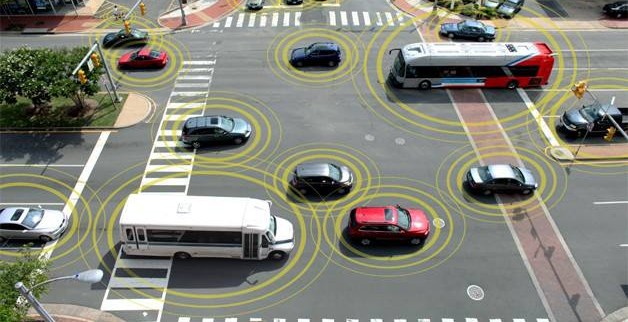We can talk to other computers, so why can’t our vehicles talk to each other? Well, if some researchers and tech companies have their way, they will. New features debuting in 2015 will show car buyers something they’ve never seen before. The Audi A5, for example, has a 7 inch screen that unfolds from the dash. It will use a 4G wireless modem to connect to the Internet, navigate Google Maps, browse Facebook, and offer a Wi-Fi hotspot right in the vehicle.
This makes some people more worried about a “connected vehicle” that can talk to you and offer you more distractions while driving. But some vehicles in the future may also be coming equipped with communication systems that assess road safety by “talking” to other vehicles on the road.
The Problem With Hands-Free Devices
There’s some interesting research coming out that suggests that all of these hands-free devices that manufacturers are equipping vehicles with don’t add up to a safer driving experience. Some manufacturers are actually making the problem worse, according to some, because they’re introducing distractions that weren’t there before.
For example, systems that allow you to surf Facebook while driving – some argue this is totally unnecessary and dangerous.
Watson Goepel, a Vancouver car accident lawyer, witnesses the effects of distracted driving all the time. The law firm routinely defends victims of car crashes from those that were driving while texting or talking or fiddling with something else in the vehicle.
Some studies even suggest that distracted driving is worse than drunk driving, making you less aware and able to react than if your BAC were to exceed the legal limit.
Regardless of state laws on distracted driving (some states don’t recognize it as dangerous), the research is becoming very clear – distracted driving leads to a dramatic increase in the risk of being involved in an automobile accident.
How A Connected Vehicle May Solve These Problems
Connected vehicles, like those proposed by the U.S. Department of Transportation (DOT), may help reduce the risk of distracted driving by implementing a unique system of vehicle-to-vehicle communication. the Manufacturers, like GM, Ford, Hyundai, Volkswagen, and Mercedes-Benz are in agreement – something needs to be done.
Vehicle-to-vehicle communication systems would allow your vehicle to “talk” to other vehicles on the road about relative speed of all vehicles, the location and direction each vehicle is traveling, and then provide analysis and warnings, when necessary.
Manufacturers want to put warnings in their vehicle to alert drivers of vehicles approaching their blind spot, for example. Forward collision warnings may add additional safety to automatic braking systems when vehicles get too close to one another and the computer calculates that a crash is imminent.
Electronic emergency brake lights will warn others on the road when a vehicle far from the driver’s sight brakes hard.
Intersection movement assistance can also be provided to help minimize the risk of an accident in intersections. These warnings will alert drivers when it is unsafe to enter an intersection. This warning is particularly helpful when you want to enter an intersection but your view is blocked by current traffic conditions or the layout of the intersection.
Finally, passing warnings will alert drivers when it is unsafe to pass another vehicle on the road.
Deborah Hargrove is a driving instructor. She enjoys researching driver safety and her articles mainly focus on best driving practices. She enjoys sharing her research and ideas online.


